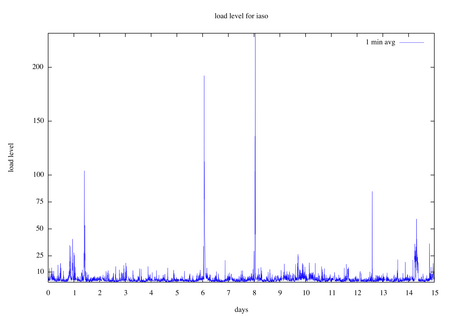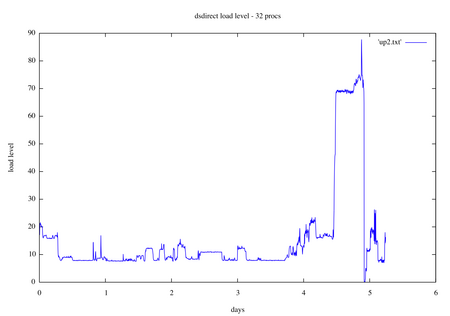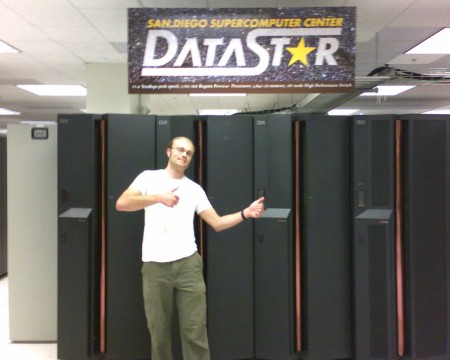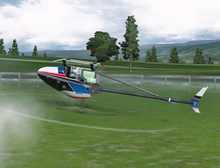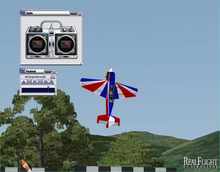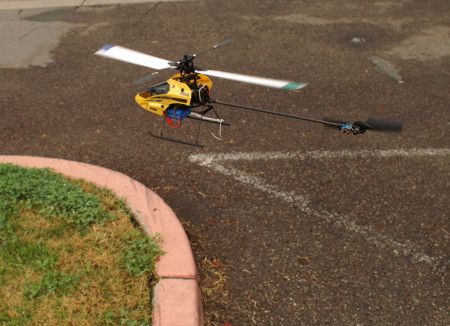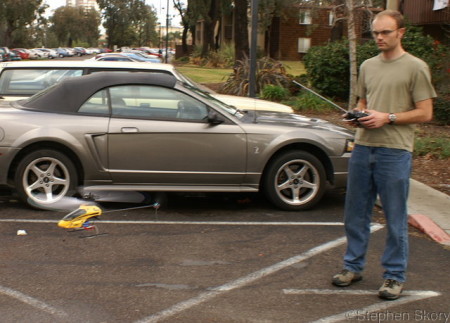Damn You May Gray
No, May Gray isn't a person, it's a Southern California phenomenon that happens during the months of May and June. In June it's called "June Gloom." Let me put it simply. Here is the Berkeley 5-day forecast off of Wunderground:
and here is the La Jolla 5-day forecast:
I miss the sun.
more ...Site5 Could Be Better
A week ago I saw a posting on digg about how Dreamhost sucks. It got me thinking about the problems I've been having with my account with Site5. Let me say that at no point has my experience been anywhere as bad as the one described in that link.
My hosting plan is on a shared webserver. Here is an informative page (broken link) about my machine, named iaso. It has four Intel 2.8Ghz Xeon processors, and four gigabytes of RAM. It runs Linux which is a solid server OS.
My big problem are periods when this very website is unresponsive. There are lots of other websites on the same computer. And by lots I mean on the order of 600 websites:
-bash-3.00$ cat /etc/passwd | grep -v nologin | wc -l<br />
646
The number of users with logins is not a one to one list of websites served, but it's probably a good estimate. All it takes is one of the 600 users with a bad webpage to clog up the machine.
Below is a plot of the load level for iaso over the course of 15 days last month. Without going into specifics, a load level of one means that there is one process needing a processor at any given moment. It will be many different processes, and that's fine. Practically, a machine can stay responsive with up to about a load of three or four per processor. So, on a four processor machine like iaso, a load level of 10-15 is about the highest comfortable level.
What you see above are many occasions when iaso went well above load levels of 25. The highest peak was a load of 230. In my experience, once the load reaches 25 my website becomes more than slow: it doesn't work anymore.
For comparison, below is a plot of the same thing on one of the nodes of the supercomputer I use, Datastar. This is the node where scientists do heavy-duty analysis on their datasets. For instance, I use this node to process my multi-gigabyte datasets using IDL. People also run Mathematica and other very computationally intensive tasks on this machine. It's got 32 1.7Ghz Power4 processors and 256GB of RAM (what do you have on your workstation, huh?). It runs IBMs AIX 5.3. As you can see below, for the first four days, the load level stays below one process per processor. In the fifth day something happens and it goes above 60 for a while, before the machine gets rebooted and things return to normal.
The kind of processes that run on the two computers above are very different. However, the supercomputer is supposed to run big jobs and get beat on. A webserver isn't. Anytime the webserver's load goes above 25, it's like the supercomputer's load shooting to 256. At no time did the supercomputer shoot to 256, while the webserver goes above 25 many times. Of course, I'm comparing 15 days to 5 days in the two plots, but I think the differences are clear.
Site5 pays a third party to monitor their webservers, with results listed here (link broken). iaso (link broken) has 99.8% uptime overall and 99.4% over the last month. This is bad enough that apparently I'm due a 5% credit on my next billing cycle. iaso isn't even living up to Site5's own service standards.
Every time I catch my website being slow, I contact Site5 tech support. I know that this is a common problem with shared hosting. I'm sure that Site5 is aware that these outages, and does what they can when they happen. But, when it does happen, it's annoying. It shouldn't happen in the first place. Sometime this summer, Site5 is changing their hosting solution which may help with these problems. We'll see.
more ...Ethics Course
I guess the UC system has been working it's way down the ladder of the compensation scandal hierarchy. I thought they had forgotten about that sweetheart deal I gave to absolutely no one. I finally got my invitation today to learn how to stop myself from doing absolutely nothing again. I've decided to include you with me as I clean up my act. Off we go!
Page 1: What? No pig latin? Utbay tsiay hatway mIay ostmay omfortablecay ithway!
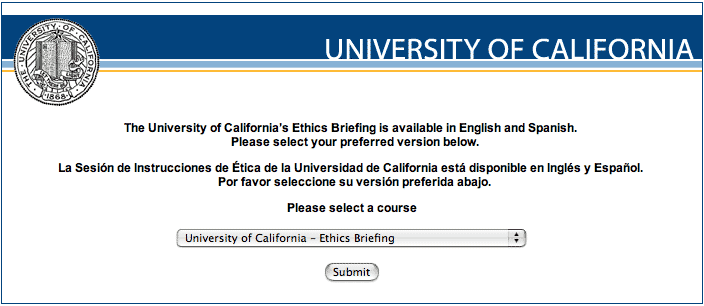

Page 2: It's our President, Robert Dynes, with a video message. From the video it's clear he's not used to the talking head bit. His eyes are a good 15 degrees away from the camera the whole time. My favorite part is when he says "I liked it" when referring to taking the ethics course himself. If he really did enjoy it, he's disturbed.
Page 3-5: Blah blah blah. Introductory text, a short outline of the course.
Page 6: This reminds me of Dilbert comics I've seen before. The last one below has me thinking -- when was the last time a graduate student really felt like their dignity was being respected? I suppose in the end we only have ourselves to blame since we got ourselves into this mess.
We are committed to the following principles:
Integrity. We will conduct ourselves with integrity in our dealings with and on behalf of the University.
Excellence. We will conscientiously strive for excellence in our work.
Accountability. We will be accountable as individuals and as members of this community for our ethical conduct and for compliance with applicable laws and University policies and directives.
Respect. We will respect the rights and dignity of others.
Page 7-8: I'm given the "Standards of Ethical Conduct." In summary, except for the financial reporting bits, it's pretty much the same thing you might get in your high school welcome book. Respect others, respect yourself, do right for yourself, snitch on others. That sort of thing.
Page 9: Oooh. We're finally getting relevant to me now. We're going to follow the ethical decisions of "Edna" the Business Manager of a large department. This describes my position and responsibilities as a physics graduate student.
Page 10-13: Uh ohs, Thuvan (a name I've never heard before) is taking perks from hotels. Thuvan schedules large conferences and chooses hotels which will receive this business. Thuvan is spending all day hanging out at hotels getting free food and services. It looks like Edna has to talk to her about following ethics rules.
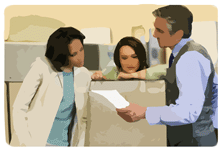
Page 14-17: A professor just got a big grant, and wants to hire the department chair's wife for a position, but without doing a proper job search. Tim wants to play along so there's no trouble from the professor, but Edna knows better. It looks like Edna has to sit down with another employee. Notice the slick graphics to help me visualize the situation.
Page 18-22: A professor has found a desirable, young and grant-rich researcher at another institution, and would like to hire her. But in order to do this, her salary would be higher than university standards. Oh no! Do we follow the rules or ";make a secret promise to raise the salary in a year?" We follow the rules, of course.
Page 23-45: I'm going to be nice to you and speed you over the rest of Edna's ethics situations. She really has got a bunch of lousy employees. The only things I learned that apply to me are: Don't steal lab equipment (no one will notice a super computer missing, will they?) and don't gossip to the media when your lab-mate gets arrested (I'll just do it anonymously, guys).
Page 46-48: Just use common sense, dammit! Well, it didn't say dammit, but it should have.
Page 49-51: Here they're just insulting me. They give an example of a campus gardner who used what he learned from an online ethics course in a few sticky situations. They're attempting to show that even low-level employees have ethics choices to make. But even here, this gardner has more power over facilities and purchasing decisions than I do. I want them to give the example of an employee like me that applied what he learned. The problem is, I have power over nothing. No one is going to put me in a sticky situation because I have nothing to offer in return.
Page 52: Regent Parsky gives me a video message thanking me for taking the course. No, thank you Regent Parsky.
Page 53: An offer to provide feeback and a certificate of completion!!! Whew. Now I feel validated. This is going up in my office so everyone knows my ethics are unreproachable.

Congratulations to you if you read this far.
more ...Update: Helicopter
I left my helicopter alone for over a month recently because I had become frustrated. It seemed that all of a sudden, my ability to fly had eroded. I could no longer keep the heli stable. Other times, the heli would be twitchy and erratic and unflyable, while even just sitting on the ground with no input from the control sticks.
After the internet provided no clues about the twitching, I took it to a local shop. The shop tech guessed I had a bad crystal in the receiver. As soon as he popped in a new set (in the transmitter too, of course) the heli was as good as new.
Since then I've bought a new Lithium-Polymer battery that allows nearly 20 minutes of flying time, compared to the 5-7 from the included Nickel-Metal Hydride battery. I also bought a different motor which the helicopter manufacturer recommends for maximum flight time. The old battery still works, but it is not as satisfying as the new one.
Below is a video of me taking the heli up to about eye level, (well out of ground effect) hovering for a few seconds, and bringing it back down safely. I think the heli looks far more stable that it did in my last post on this topic.
Since I made the above movie a few weeks ago, my helicopter is again on the fritz. This time, it's the tail motor which no longer works. The tail blades very easily strike the ground, and this causes the tail rotor to slow down (obviously). In order to speed the tail rotor back up, a quick burst of current is required, which repeated enough times eventually burns out the motor. The symptom is a nearly uncontrollable heli. I have burnt out two tail motors.
Since I don't want to continually buy new tail motors ($10 a pop), I went ahead and bought myself the RC simulator I yearned for only two weeks ago. As you can see in the movie below, crashes in the virtual world are much less devastating:
In this movie I'm flying using the night mode, which puts lights at the tips of the rotors so you can see the orientation of the heli. Red and blue on the main rotors; yellow on the tail rotor. Please excuse the poor quality of the video as I made it with my (relatively) antiquated digicam. I would have used a software video capture program, but they're (very) not free and cause the computer to slow down so much that the aircraft is uncontrollable. Below is a video showing a bit more flying skill and no crashes:
My goal with the simulator is to improve my instincts and reflexes, so when I return to the real world, I'll have mastered all the basic skills. It's also fun to fly and not have to worry about real world consequences.
more ...Yahoo! Mail support is a joke
For some reason, lately when I go to Yahoo! Mail (mail.yahoo.com), occasionally instead of going to my inbox, I get a page of raw PHP. Here are the first few lines:
<?PHP
ini_set('display_errors', 0);
$data = yahoo_reg_login_setup();
if ( $data === FALSE )
{
exit();
}
else if ( ! isset( $data['DISPLAY_FORM'] ) )
{
error_log( "yahoo_reg_login_setup didn't set the DISPLAY_FORM field" );
header( "Location: http://login.yahoo.com/");
exit();
}
Here is the rest of the PHP code. It is obviously the PHP code that runs the base of Yahoo! Mail, which decides where to forward you: either to your inbox or to a login page. At any rate, there's no reason why Yahoo! Mail's servers should be sending me raw PHP.
When I get this page, if I hit 'refresh' I'll get the correct page, so things aren't totally broken. This slightly annoying, and it's obviously a problem with Yahoo! Mail's servers. My web browser is incapable of producing raw PHP code, much less with a Yahoo! Mail bug tracking number (see the full text).
Trying to be proactive, I sent this code to their help department. I also wrote "Please don't tell me it's my problem, as there is no way my browser can generate raw PHP." They wrote back telling me:
We understand that you're receiving a HTML error message in your account ... To help us troubleshoot and assess the issue, please take a screenshot of the entire page when the issue occurs next.
They then proceed with instructions on how to take screenshots in Windows. As a Mac OS X user, I found this help insulting and useless. I am no common Windows user, and they shouldn't assume I am. Furthermore, providing a screenshot is even less helpful than my original post, as the PHP code covers more than one contiguous window - I have to scroll to see all the PHP code. It's clear that either my message wasn't read, or the person reading it had no idea what I was saying and put in the most general pre-written reply they could find.
It says something about your company when this kind of 'help' is allowed. This person should have forwarded my message to someone who had a clue. They shouldn't have sent me anything, much less nonsense, when they no idea what I was writing about. Perhaps there is no conduit for this kind of thing between the Yahoo! Mail help staff and the actual programmers. If that's the case, it's a shame, and it's more evidence why Google is kicking Yahoo's butt.
more ...RC Simulator
Lately I have been enjoying flying my Blade CP helicopter. I've purchased a new battery/motor combination that has extended my flight times to about 15 minutes. I've also become proficient enough that I can (usually) run the battery down before I break anything crucial. However, there's still limits to my flying. The battery takes roughly two hours to charge. I try to keep myself from overstepping my skill level. Of course I have to try new things in order to learn, but I've found that if I get too aggressive, I make costly mistakes.
It is time for me to greatly increase my practice time through the magic of personal computers. Behold the Realflight G3.5 RC Flight Simulator. This simulator comes with a USB controller with the same look and feel as a RC transmitter. The program has a large library of fixed wing aircraft and helicopters that can be flown in a variety of locations, indoors and out. It has a good physics engine and "real" obstacles. This means that if you try to fly through the scenery, you'll crash into it. The plane will even break apart in a realistic amount. For a small crash it might lose a tail. For a big crash, it will break apart into many parts.
The best thing about the simulator is the big red button on the USB controller that instantly resets everything after a crash. That's much cheaper than the real world!
As is usually the case, this is a Windows-only program. Luckily for you, you don't have to buy me a PC so I can play this, as Melissa has a Dell. It isn't the fastest thing, but it is capable of running the application.
more ...College Sports Heterogeneity
Most of my faithful readers are not college sports fans. Therefore, you are probably not aware that the men's basketball national championship in two days will be between Ohio State and Florida. These are the same two teams that met in the football championship in January of this year.
As a Cal fan, I've learned that the Berkeley football team and men's basketball team cannot both be competitive at the same time. More likely, neither will be all that successful. When I was in school, the football team was awful. I believe they lost somewhere in the neighborhood of 16 in a row over two seasons. They also never beat Stanfurd in the "Big Game" while I was an undergraduate. The basketball team was somewhat more capable. While they would usually lose against top opponents, they at least won more games than they lost by a comfortable margin.
Lately, the rule has stayed true. The football team has been excellent for the last few years, while the basketball team has been less than mediocre. All as is it should be in the Cal athletics world.
The best explanation of this phenomenon is that Cal is a legitimate academic powerhouse. Any school that's worth attending will, and should, stink at high-level popular sports. Sure, Cal is dominant at rugby. The Cal women's basketball team made it to the NCAA tournament this year, unlike the men. Cal is good at water sports like swimming and crew, too. Actually, Cal is all-around good, as their current third place in the Sears Directors Cup shows. All of that doesn't matter to me. Let me know when NCAA lacrosse makes it to prime time and I'll update my rules (a.k.a. chauvinism).
All of this is leading to my main point: Ohio State and Florida graduates should be on high suspicion of their worth for the next few years. They should be looked at with the same eye as Devry or University of Phoenix graduates. It is no secret that athletes are not academic superstars. There's a reason why these schools have attracted the best performers. If you're looking to attract the best athletes, you've got to show them that they can keep their grade point average high enough for NCAA eligibility. Bluntly, they ain't gonna get it done at a place like Cal.
Perhaps, someday in the future, Cal will be proficient at both men's basketball and football at the same time. And I will be forced to eat my words. If you are a true blue like me, you're not too worried about this.
more ...Concrete
3m 11s playing time, 1917 frames, 7h 39m, ~13s between frames, March 20, 2007
Perhaps it's the nature of pouring concrete, or union jobs, but the middle of this time lapse is pretty boring. Sorry about that. The beginning is fun enough; and the end, with the inch-worm workers and the vacuum-like concrete massager, is cool, too.
Please note the right 1/3 of the image is slightly affected by the reflection of the building façade on the window.
more ...Mosaic Time Lapse
Your challenge is to figure out what the image is as quickly as possible. I'll wait!
Some of you may remember my photo mosaics I played around with a while back. This is exactly that, but this time, I took a screen shot every 20 seconds or so as the program refined the image.
This mosaic is made up of a bunch of "glyphs" which are a colored square with a colored letter/symbol in the middle. The colors and symbol are randomly chosen. The movie above compresses about 8 hours of real time into under two minutes. In that 8 hours the program tried over 330,000 glyphs for the 2500 tiles on the image. The interesting thing is the basic shapes in the image resolved themselves quickly, while the colors took much longer, and never really matched the original image.
Here is a link to a composite photo, showing the original photo and the final mosaiced photo. I don't think the mosiac really captures my tongue accurately.
more ...Neighbors Deck
1000 frames, 3h 40m, ~13s between frames, February 22, 2007
This time lapse was shot before, during, and after the passing of a rain front. See if you can tell when the rain starts. The most interesting thing to follow are, of course, the clouds, which change direction & speed. The clouds really get moving on the backside of the front.
more ...Blade CP
I promised several of my faithful readers multimedia of my new E-Flite Blade CP in action, so here it is. Below is a short movie showing my lack of skills. In my defense, I didn't crash and it was windy today (you can hear the wind on the microphone). When I first started flying the Blade CP, I definitely would have crashed the helicopter in wind like this.
The Blade CP is an electric helicopter with separate main and tail motors. It features Cyclic/Collective Pitch Mixing that uses three servos which move in concert to raise and tilt the swashplate. The swashplate is connected to a flybar, which is then connected to the main rotors. This is called the Hiller control mechanism. The electronic throttle is linked to the collective, so as the throttle increases, the overall pitch of the blades gets steeper. The helicopter also features a gyro that helps keep the helicopter stable and pointing in one direction (yaw). If I get proficient enough with the helicopter, I can upgrade several parts which will enable aerobatic & inverted flying.
more ...A Bit of Shiny
Below is a little animation that I made yesterday that shows what I have been doing lately. The green dots correspond to the positions of dark matter particles, while the little yellow squares are the locations of dark matter haloes that I'm interested in. The white lines are the edges of the simulation volume, and you can see the axes triad in the bottom-left corner. To give you an idea of the scale of what's depicted here, each edge of the cube is 50 Mpc, or 163 million light years. Our entire galaxy is only about 20 kpc or 65,000 light years across.
In the first part of the movie, the cube is rotated about its center. Next, while looking along the z-axis, the volume of the cube plotted is reduced until only 1/10th of the cube is shown. Then, this 1/10th thickness is scanned through the entire cube, and then the volume plotted is replenished back to full.
The things to notice are how the dark matter form areas of high density, which are connected by filaments. Between these are areas of relatively few particles, which are called voids. This is how our universe really looks, with huge collections of galaxies clustered together, separated by huge expanses of nearly empty space. I should point out that there are many more galaxy haloes in this box besides the yellow boxes.
What I was looking for was one of those yellow boxes which is fairly isolated from areas of high density dark matter. I picked one, and now I am doing this same simulation again, but with higher resolution boxes centered on the area of interest. The simulations I'm doing right now are fairly cheap (in computer time currency). I want to be sure that when I run big, time-intensive simulations in the future that I've picked a good area to focus my attention on.
I did this visualization with Visit, a stereo, 4D visualization tool out of the Livermore National Lab. The "stereo" means that it can create two images of the same data that are slightly offset, which create a 3D effect if viewed correctly. The fourth dimension is for time, as it can handle time-ordered data sets. I then used Visit's Python scripting features to output 800 individual PNGs, which I then stitched together (exactly like my time lapse movies) to make this movie.
more ...New Price Center
Taken from the SERF Building on February 1, 2007.
I would have liked this time lapse to cover more time, but the internal camera battery died because I didn't fully charge it. I did have my external battery plugged in, but the camera cannot run off that alone. Also, since these images are very complex, even JPEG compression cannot reduce their size too much, and I nearly filled my 1gb card. For example, my previous time lapse project, Airport Sunset, I took over 600 more photos than this time. The difference is those frames had nearly half devoted to the sky.
more ...Airport Sunset
Laurel and Union streets facing nearly west January 15, 2007
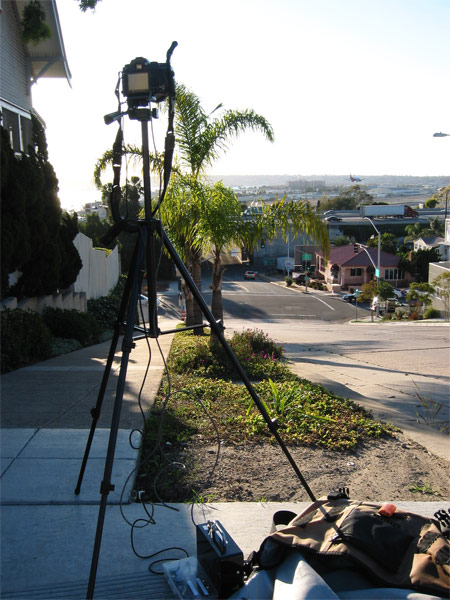
The external battery pack and "intervalometer" are connected to the camera. I was hoping to capture the Comet McNaught but it has become too close to the sun now. Next time I have a freeway in a time lapse I'll situate it longitudinally so apparent motion is clearer.
more ...

